Cancer is a relatively common health concern in cats, and can occur in various forms affecting different organs and tissues.
Older cats are more prone to developing cancer and certain cat breeds may have a higher predisposition to specific types. For example, Siamese cats may be more prone to mammary tumors and Persian cats may have a higher risk of developing squamous cell carcinoma.
Cats with cancer often have special dietary requirements, and their nutritional needs may vary depending on the type of cancer, its stage, and the overall health of the cat.
As always, it’s important to feed your cat a high-quality, balanced diet that provides essential nutrients. Your veterinarian may recommend a prescription diet designed for cats with cancer.
Cats with cancer may experience weight loss, so providing a diet with increased caloric density can help maintain their body weight.
Protein is crucial for maintaining muscle mass, and a diet with high-quality protein may be beneficial. However, the protein levels may need to be adjusted based on the type and stage of cancer.
Omega-3 fatty acids may have anti-inflammatory properties and could be beneficial for cats with cancer. Fish oil supplements or diets rich in omega-3 fatty acids may be recommended.
Offering smaller, more frequent meals throughout the day may be easier for a cat with cancer to manage, especially if they have a decreased appetite.
Always consult your veterinarian before making any changes to your cat's diet. They can provide specific recommendations tailored to your cat's health condition, and they may also suggest additional supplements or treatments to support your cat's overall well-being.
Regular veterinary check-ups are essential to monitor your cat's condition and make adjustments to their care plan as needed.
Our top picks
- Open Farm Homestead Turkey Rustic Blend (Wet) Jump to review
- Hill's Prescription Diet ONC Care Chicken & Vegetable Stew (Wet) Jump to review
- Nulo Freestyle Freeze-Dried Raw Turkey & Duck (Dry) Jump to review
- Stella & Chewy’s Tummy Ticklin Turkey Morsels (Freeze-Dried Raw) Jump to review
- Vital Essentials Beef & Chicken Entrée (Freeze-Dried Raw) Jump to review
-
Open Farm Homestead Turkey Rustic Blend (Wet)
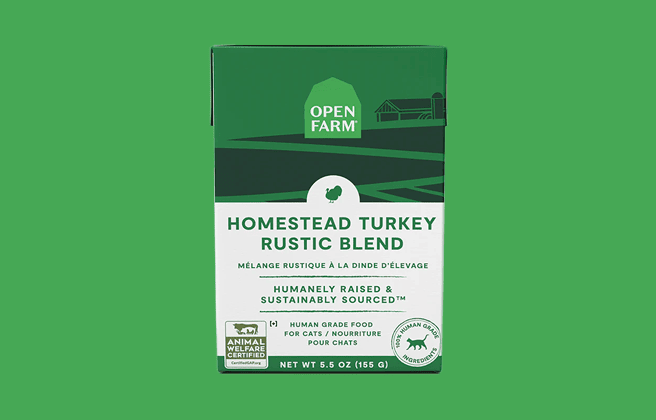
Open Farm Homestead Turkey Rustic Blend received the Cat Food Advisor’s rating: 4 stars.
It is one of six wet cat foods in a range made by the Canadian company, Open Farm Pet Foods, which focuses on using locally sourced ingredients from farms that meet strict animal welfare and quality standards.
Open Farm Homestead Turkey Rustic Blend gets the bulk of its protein from turkey, which is naturally rich in the 11 essential amino acids a cat requires to sustain life.
Dry matter label analysis reveals a wet recipe containing 44.4% protein, 33.3% fat and 14.2% carbohydrates . . . with a fat-to-protein ratio of 75%.
Open Farm wet cat food is made from ethically and sustainably sourced meat. It includes added fruits, vegetables, and coconut oil. This food is made in the USA and contains no artificial colors, flavors, or preservatives which have no nutritional benefits to cats.
Read our review of the full Open Farm (Wet) range hereThings we like
- Human-grade ingredients
- Meats from audited high-welfare farms
- No artificial flavors, colors and preservatives
Main Ingredients Humanely raised turkey, turkey bone broth, pumpkin, carrots, spinach Texture Wet Type Grain-free Protein Percentage 44.4 AAFCO Standards Maintenance Best For Cats and senior cats EXCLUSIVE: New customer offer
20% off first auto-ship order with code CFA20
Sample buyer review...
"Lilith loves all of her Open Farm Wet Cat Foods. Alone or mixed, there is never any left in her dish. It also meets her nutritional needs to stay healthy and maintain an appropriate weight. We love that Open Farm maintains high standards and sources humanely treated animals/poultry/fish for their products. "
-
Hill's Prescription Diet ONC Care Chicken & Vegetable Stew (Wet)
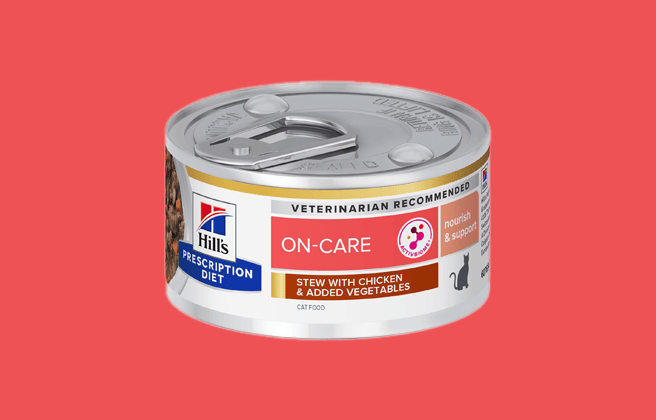
Hill’s Prescription Diet ONC Care Chicken & Vegetable Stew received the Cat Food Advisor’s highest rating: 4.5 stars.
This recipe is one of 29 in a range made by Hill’s Pet Nutrition, an international pet food brand known for selling scientifically developed foods.
Hill’s Prescription Diet ONC Care Chicken & Vegetable Stew cat food recipe derives the bulk of its protein from chicken, which is naturally rich in the 11 essential amino acids a cat requires to sustain life.
Dry matter label analysis reveals a wet recipe containing 42.5% protein, 24.9% fat and 24.8% carbohydrates . . . with a fat-to-protein ratio of 59%.
Hill’s uses qualified experts to formulate its products in one of the world’s leading research facilities. Some blends are great for cats of all ages, from kittens to seniors as well as recipes to suit cats with health conditions.
Read our review of the full Hill’s Prescription Diet (Wet) range hereThings we like
- Science-led ingredients
- Wide range of products for different cats
- Quality protein ingredients
Main Ingredients Chicken broth, pork liver, chicken, carrots, wheat gluten Texture Wet Type Grain-Free Protein Percentage 42.5 AAFCO Standards Adult maintenance Best For Cats and senior cats Save up to 35%
with Autoship
See discount in cartSample buyer review...
"My cat has terminal cancer and finding a food he would eat was a challenge. Our vet recommended this diet and it was unavailable at their office and with Hills to Home. This food has been a blessing. Not only does he like this food, he has already gained back some of the weight he lost. "
-
Nulo Freestyle Freeze-Dried Raw Turkey & Duck (Dry)
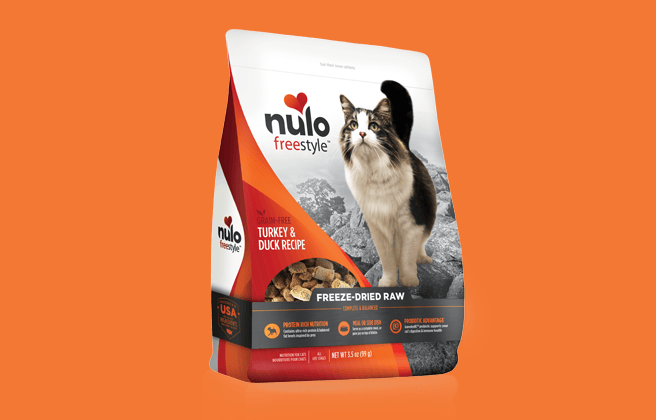
Nulo Freestyle Freeze-Dried Raw Turkey & Duck recipe received the Cat Food Advisor’s highest rating 5-stars.
It is one of two recipes in this dry product range made by Nulo, a company founded in 2009 by Michael Landa and Brett Montana, after seeing the high rates of diabetes and other medical issues in dogs and cats while running their pet-sitting business.
Nulo Freestyle Freeze-Dried Raw Turkey & Duck Recipe derives the bulk of its protein from turkey, which is naturally rich in all 11 essential amino acids required by a cat to sustain life.
The dry matter label analysis reveals a dry recipe containing 44.2% protein, 38.9% fat and 8.8% carbohydrates, with a fat-to-protein ratio of 88%.
Nulo Freestyle gives cat parents a convenient way to feed their cat a raw diet without the need for refrigeration or freezing. The freeze-dried raw food can be rehydrated with water or fed as a dry treat. It typically contains a high amount of animal-based protein and is free from grains, soy, corn, wheat, and artificial preservatives.
Read our review of the full Nulo Freestyle (Freeze-Dried Raw) range hereThings we like
- Contains probiotics
- Grain-free
- Protein rich
Main Ingredients Turkey, turkey necks, turkey liver, duck, duck liver Texture Dry Type Freeze-dried Protein Percentage 44.2 AAFCO Standards All life stages Best For Kittens, cats and senior cats Save up to 35%
with Autoship
See discount in cartSample buyer review...
"Before I found out about Nulo, my three-year-old Torti just got the basic treats that, truthfully, I had no idea what they were made from. Now I know she is getting the great protein she needs and food she LOVES! Thank you Nulo!! "
-
Stella & Chewy’s Tummy Ticklin Turkey Morsels (Freeze-Dried Raw)
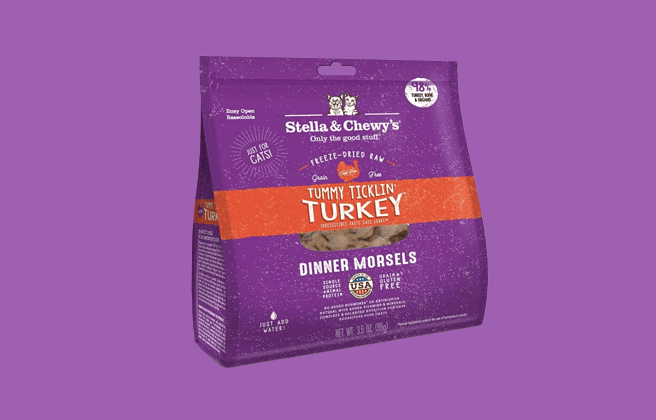
Stella & Chewy’s Tummy Ticklin Turkey Freeze-Dried Raw Morsels received the Cat Food Advisor’s second-highest rating: 4.5 stars.
It is one of six recipes in this product range made by Stella & Chewy’s, a company founded by Marie Moody who, after adopting two dogs named Stella & Chewy, began to pursue her passion for pet nutrition.
Stella & Chewy’s Tummy Ticklin Turkey Freeze-Dried Raw Morsels derives the bulk of its protein from turkey, which is naturally rich in the 11 essential amino acids required by a cat to sustain life.
Dry matter label analysis reveals a dry recipe containing 42.1% protein, 38.9% fat and 10.9% carbohydrates, with a fat-to-protein ratio of 93%.
The food is made with real chicken, including muscle meat, organs, and bones. It is then freeze-dried to preserve the nutritional value and flavors of the ingredients. The freeze-drying process removes moisture while retaining the essential nutrients, making it a lightweight and shelf-stable option.
Read our review of the full Stella & Chewy’s Dinner Morsels (Freeze-Dried Raw) range hereThings we like
- Rich in animal protein
- Free of animal by-products
- Made without artificial colors, flavors and preservatives
Main Ingredients Turkey with ground bone, turkey liver, turkey gizzard, pumpkin seeds, potassium chloride Texture Dry Type Freeze-dried raw Protein Percentage 42.1 AAFCO Standards All life stages Best For Kittens, cats and senior cats Save up to 35%
with Autoship
See discount in cartSample buyer review...
"These freeze-dried dinner morsels were such a hit with our cat. She loves them. They have probiotics, vitamins and minerals and are a super healthy option for your feline friend! "
-
Vital Essentials Beef & Chicken Entrée (Freeze-Dried Raw)
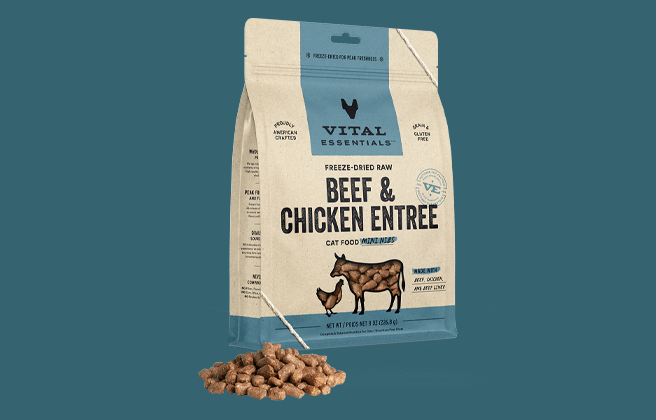
Vital Essentials Beef & Chicken Entrée received the Cat Food Advisor’s second-highest rating, 4.5 stars.
It is one of six freeze-dried raw recipes in this product range made by Vital Essentials, the flagship brand of Carnivore Meat Company — a leading manufacturer of raw frozen and freeze-dried pet foods and treats in America.
Vital Essentials Beef & Chicken Entrée freeze-dried raw recipe derives the bulk of its protein from beef, which is naturally rich in the 11 essential amino acids a cat requires to sustain life.
Dry matter label analysis reveals a dry recipe containing 41.3% protein, 39.1% fat and 11.6% carbohydrates . . . with a fat-to-protein ratio of 95%.
Vital Essentials Mini Nibs cat food is high in protein and essential fatty acids. Freeze-dried ingredients can be considered nutritionally superior to meat meals due to the gentleness of the process used to create them.
Read our review of the full Vital Essentials Mini Nibs (Freeze-Dried Raw) range hereThings we like
- High animal-sourced protein
- No added hormones or antibiotics
- Grain-gluten free
Main Ingredients Beef, chicken, beef liver, beef kidney, herring oil Texture Dry Type Freeze-dried Protein Percentage 41.3 AAFCO Standards All life stages Best For Kitten, cats and senior cats Save up to 35%
with Autoship
See discount in cartSample buyer review...
"I am a veterinarian with considerable post-graduate education in pet nutrition. I am a huge fan of freeze-dried raw formulas for cats and Vital Essentials is one of the best in this small, but growing, segment of the pet food industry. My cats are thriving on it and I intend to feed it to every cat I ever care for. "
Best cat foods
When a cat is diagnosed with cancer, pet parents often have numerous questions and concerns about their feline companion’s well-being. We have put some of these questions to our team of experts to give you some advice — but please remember to consult with your veterinarian too:
What are the most common types of cancer in cats?
Cancer can affect various organs and tissues in cats. However, some types are more common, such as:
- Lymphoma is one of the most prevalent cancers in cats. It affects the lymphatic system and can occur in various organs, including the intestines, kidneys, and nasal cavity.
- Squamous Cell Carcinoma (SCC) which is often seen in areas with less hair, such as the ears, nose, and around the eyes. It is particularly common in white or light-colored cats and is often associated with sun exposure.
- Mammary tumors are more common in female cats that haven’t been spayed. The risk of these tumors increases with age, and they can be malignant or benign.
- Fibrosarcomas are tumors that originate in fibrous tissues and can occur at injection sites. This is a rare but aggressive type of cancer.
- Cats can develop various types of oral cancers, including squamous cell carcinoma, fibrosarcoma, and others. These tumors can affect the gums, tongue, and other oral structures.
- Soft tissue sarcomas can develop in various soft tissues, such as muscles or connective tissues. They may occur at vaccination sites or other injection sites.
- Osteosarcoma is a bone cancer that can affect cats. It is more common in larger breeds and tends to occur in the long bones.
- Hemangiosarcoma is a cancer of the blood vessels and can affect various organs, including the spleen and heart.
What are the treatment options available for my cat’s specific type of cancer?
The treatment options for cats with cancer depend on various factors, including the type of cancer, its stage, the overall health of the cat, and the owner’s preferences.
Veterinary oncologists work with pet parents to develop a treatment plan that aims to improve the cat’s quality of life and, in some cases, extend their lifespan. Common treatment options for cats with cancer include:
- Surgery: Surgical removal of tumors is a common treatment if the cancer is localized and hasn’t spread extensively. The feasibility of surgery depends on factors such as tumor location, size, and type.
- Chemotherapy: Chemotherapy involves the use of drugs to kill or slow the growth of cancer cells. Chemotherapy is often used to treat systemic cancers or those that have spread to multiple areas. Cats typically tolerate chemotherapy well compared to humans.
- Radiation Therapy: Radiation therapy uses targeted radiation to kill cancer cells or shrink tumors. It is often used for localized cancers, and treatment sessions may be spread over several weeks.
- Immunotherapy: Immunotherapy involves stimulating the cat’s immune system to recognize and attack cancer cells. It’s an emerging field in veterinary medicine and may be used in conjunction with other treatments.
- Palliative Care: In cases where a cure may not be achievable, palliative care focuses on providing relief from symptoms and improving the cat’s quality of life. This can include pain management and supportive care.
- Targeted Therapies: Some cancers may respond to targeted therapies that specifically target certain molecules involved in the growth and spread of cancer cells.
- Cryosurgery: Cryosurgery involves freezing abnormal cells, and it may be used for certain types of skin tumors or lesions.
- Electrochemotherapy: This treatment combines chemotherapy with the application of electrical pulses to improve the uptake of the drugs by cancer cells. It’s used for some skin tumors.
The choice of treatment depends on factors such as the type of cancer, the cat’s overall health, and the owner’s preferences and financial considerations.
What symptoms should I watch for that might indicate my cat is in pain or discomfort?
Cats with cancer may experience pain or discomfort, and it’s essential for pet parents to be vigilant and observe any changes in behavior or physical signs that may indicate distress.
Keep in mind that the symptoms can vary depending on the type of cancer, its location, and the overall health of the cat. If you suspect your cat with cancer is in pain, it’s crucial to consult with your veterinarian for a thorough evaluation and appropriate management.
Here are some general symptoms to watch for:
Changes in Behavior:
- A significant decrease in activity or energy levels.
- Cats may retreat to quiet or secluded places when in pain.
- Excessive pacing or inability to find a comfortable position.
Appetite Changes:
- Reluctance to eat or a noticeable reduction in food intake.
- Unexplained weight loss despite no change in diet.
Grooming Changes:
- Cats may excessively groom themselves or, conversely, neglect grooming due to discomfort.
- A dull or unkempt appearance to the fur.
Vocalization:
- More meowing, growling, or vocalizing, especially during specific movements or when touched.
Changes in Movement and Posture:
- Difficulty walking, jumping, or climbing.
- Hesitation or refusal to move certain body parts.
Changes in Elimination Habits:
- Straining in the litter box or showing signs of discomfort during elimination.
- Blood in the urine or stool, constipation, or diarrhea.
Changes in Breathing Patterns:
- Difficulty breathing, rapid breathing, or panting.
Aggressive Behavior:
- Aggressive reactions, especially when touched or approached.
Hunching or Guarding:
- Protecting a specific area of the body by hunching over it.
Purring:
- While purring is generally associated with contentment, some cats may purr as a self-soothing mechanism when in pain.
It’s crucial to note that cats may hide signs of pain, so subtle changes in behavior or routine may be important indicators. If you observe any of these symptoms or notice other concerning changes in your cat’s well-being, consult with your veterinarian promptly. Early detection and appropriate pain management can significantly improve the quality of life for cats with cancer.
Are there dietary changes or special nutritional considerations for my cat with cancer?
Dietary changes and nutritional considerations for a cat with cancer can play a crucial role in supporting their overall health, managing symptoms, and potentially enhancing their response to treatment. See above for more details.
What are the financial considerations associated with the recommended treatment plan?
Pet treatment and medication can be very expensive, so taking out insurance is beneficial. Not only does it help offset the costs of unexpected veterinary expenses, it can also cover a significant portion of veterinary bills, including diagnostics, treatments, surgeries, medications, and more. This financial support ensures that pet owners can provide the best possible care for their pets without facing overwhelming costs.
Chronic conditions or long-term illnesses can be costly to manage over time. Pet insurance often covers ongoing treatments and medications, making it more feasible for pet owners to provide continuous care for their pets with chronic conditions.
Many pet insurance providers such as PetInsurer offer a range of plans with varying levels of coverage. Pet parents can choose a plan that suits their budget and the specific needs of their pets. This flexibility allows for customization based on factors such as age, breed, and pre-existing conditions.
Sources
Cat Food Advisor is reader supported. If you buy using links on this page, we may earn a referral fee.
Article reviewed by
Veterinarian
Dr Georgia Jeremiah has a first class honors degree in comparative pathology with field experience in anatomic and clinical pathology, studying disease processes in a multitude of species.






